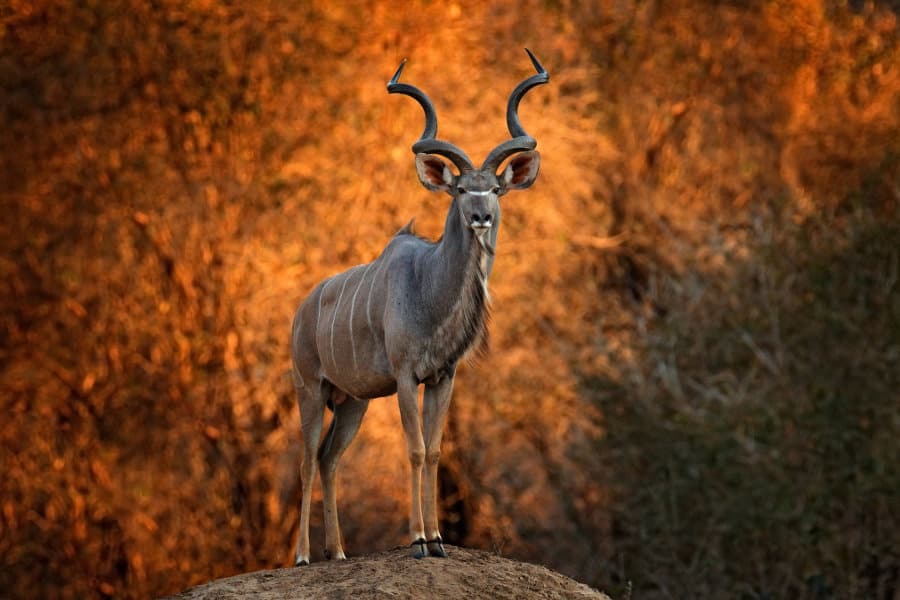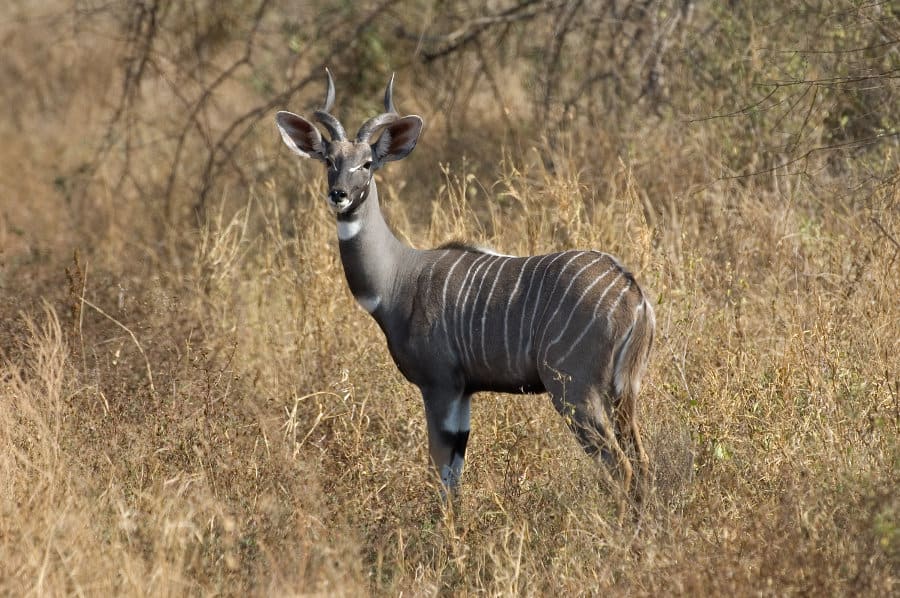The greater kudu, also known by its Latin name, Tragelaphus strepsiceros, is a beautiful representation of Africa’s vibrancy.
The woodland antelope calls the lightly wooded savanna of Southern Africa its home. As well as a few other locations in East Africa, the horn of Africa and southern Sahara.
The greater kudu has a reputation for being both curious and highly alert. This behavior can make spotting one while on a South African safari a real treat.
Here are a few fascinating facts and general information about the beautiful antelope. They should help you better appreciate your next sighting!
What is a Kudu

You’ll often hear the word “kudu” used together with other animals of similar build. As well as those with comparable behavior and appearance.
Looking through your binoculars on safari, you may find yourself asking the ranger, “Is that a kudu? Or an impala?”.
Or, if you’re particularly unfamiliar with African wildlife, asking “Is that a giraffe?”. 🙂
The greater kudu is one of two species commonly known as kudu. Here’s all that you need to know about them.
What does a kudu look like on safari?
The kudu is an antelope that boasts a magnificent reddish-brown to blue-gray coat. Their most identifiable characteristic is the 4-12 vertical white stripes that run down their narrow flanks. They also have a small, white v-shaped band located between their eyes.
Their long legs give them incredible prowess for leaping. And their ears are large and round to assist in identifying danger.
The male kudu sports majestic horns that spiral in an elongated pattern. In fact, it’s the shape of these horns that inspired their scientific name – Tragelaphus strepsiceros.
Their scientific name means the following;
- Trag (goat),
- elaphos (deer),
- strephis (twisting),
- and keras (horns).
Kudu size
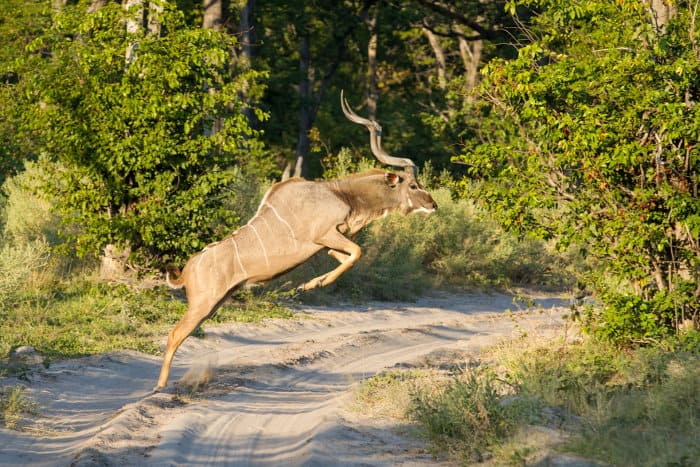
Greater kudus are one of the largest antelopes in their species. This fact makes their incredible jumping ability all the more astounding.
The bulls can reach up to 2,4 meters in length – and that’s not including their horns. Their height is equally impressive, standing at approximately 1,6 meters.
Kudu weight
The male kudus are significantly bigger, and therefore heavier, than the female kudu.
The male kudu weighs approximately 250 kilograms on average, while the female kudu weighs an average of 200 kilograms. Some of the heavier males can even reach up to 315 kilograms.
Lesser Kudu vs. Greater Kudu
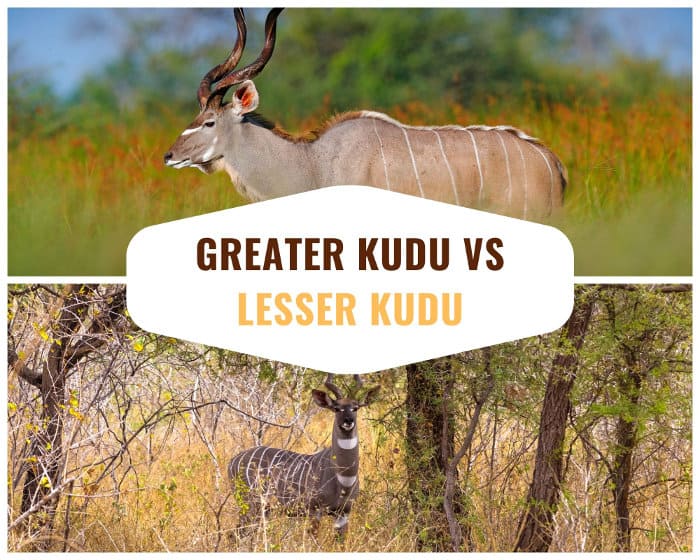
We like to think that all animals are created equal. Which makes it all the more amusing to think that the second of the two kudu species is the lesser kudu.
While both animals are equally striking, there are a few key differences that separate them biologically.
Physical differences
Firstly, the greater kudu is physically larger than the lesser kudu. The smaller antelope typically reaches 1,7 meters in length and only 1 meter in height.
Another key physical difference is that the greater kudu has a beard that grows along its throat. The beard is similar to a white fringe and adds to the majestic appearance. The lesser kudu doesn’t have this feature. Instead, it has a white patch on its neck.
The greater kudu has less white stripes with more space between each marking. The lesser kudu can have up to 15 stripes on its flank.
Males from both species have horns. However, the lesser kudu’s horns are smaller and reach only 0,7 meters in length. The greater kudu’s horns can reach an impressive 1,4 meters.
Although the greater kudu can jump impressively high for their size (3 meters or more), the lesser kudu can jump higher.
Habitat

The two species live in different locations.
The lesser kudu prefers arid savannas, populated by acacia and Commiphora thornbush trees. They find security in thickets and you’ll rarely find them in open areas.
In contrast, the greater kudu lives in the woodlands and bushlands. Although sparsely populated, they cover a widespread territory. The greater kudu also tends to stick to cover to avoid predators. However, their choice of habitat is more varied.
Kudu Bull vs. Kudu Cow
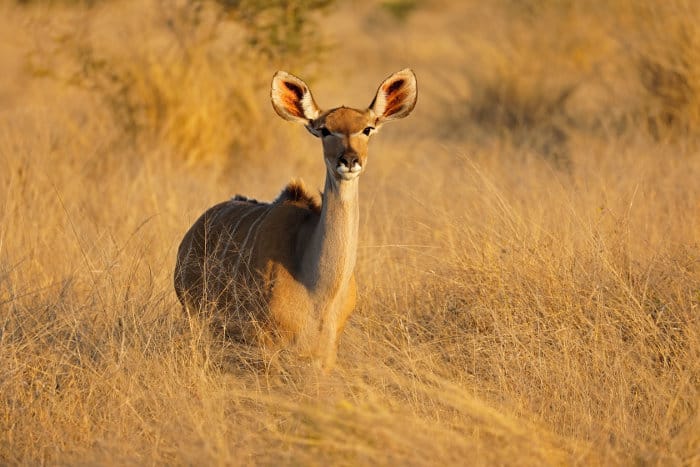
Although the same species, the kudu female and male have some striking differences. Not only are the males a lot larger than the females, but they also carry the defining feature of long, spiral horns.
While kudu bulls generally weigh up to 270 kilograms, a kudu cow won’t weigh more than 210 kilograms. The females are also significantly shorter, hornless, and don’t have any beard or nose markings.
Another significant difference between the two genders is their level of vocalism. The male kudu tends to vocalize a lot more than females, using low grunts, clucks, humming, and gasping. These sounds function as various communication forms, including raising an alert.
What Do Kudus Eat?

Kudus are browsers and get their energy from a variety of tree and shrub leaves. The kudu diet includes fruits, pods, and creepers.
During the dry season, greater kudus are even known to eat wild watermelon to stay hydrated and energized. The herbivores typically enjoy their meals in the early morning and the late afternoon.
An African Animal With Horns
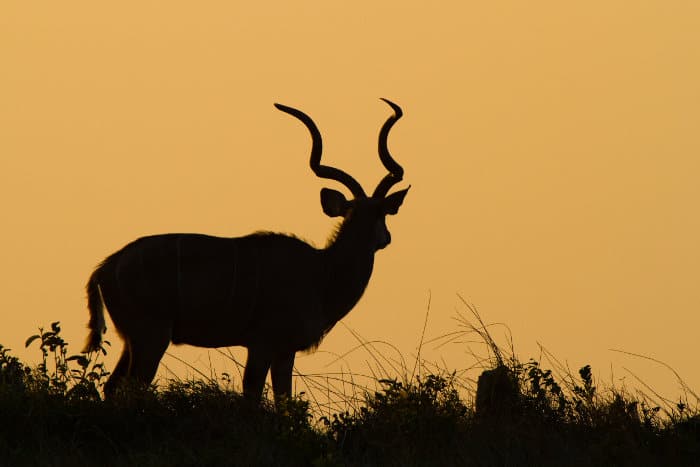
The greater kudu is one of Africa’s majestic horned animals, finding its place in the Bovidae family. Included in this family group are gazelles, wildebeest, other antelope, and even goats and cows.
Of these animals, the greater kudu is one of the largest antelopes – and arguably the most striking!
They produce some of the loudest sounds which can be identified by a gruff bark.
Their spiral horns are also a unique feature. These long kudu horns are used for sparring by the males by interlocking their keratin features.
Understanding the Kudu Lifecycle
The rutting season occurs through April to May. This behavior kickstarts the greater kudu lifecycle.
Gestation period of kudu
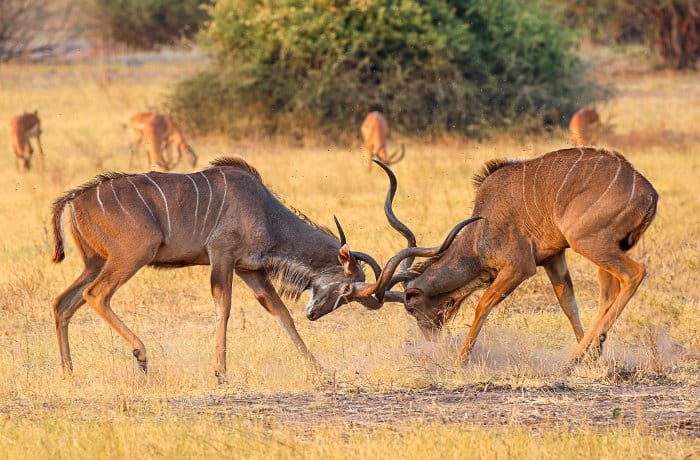
Male kudus reach sexual maturity between one and three years of age. Once that happens, they show off their masculinity by wrestling with their horns. And by making high pitched calls after the female.
Once the female permits mating, the gestation period begins and continues for roughly eight months. At the end of the gestation period, the female gives birth to a single calf.
The baby stays in hiding for up to six weeks while its mother nurses it.
Kudu lifespan
Greater kudus can live up to seven or eight years in the wild – where they should be. Sometimes, they can reach the ripe age of 15 years old. When in captivity however, they can have a lifespan of up to twenty three years.
Kudu Predators

Predators are one of the reasons that the greater kudu lives for a shorter amount of time in the wild.
Who are kudu predators?
The greater kudu has a variety of predators that they need to stay alert for (which is one of the reasons that they have such huge ears).
The cycle of life brings the greater kudu face-to-face with predators such as lions, leopards, hyenas, and wild dogs. And sometimes even pythons can be a threat to their young.
Humans also pose a serious risk to the lives of greater kudu. It’s not uncommon for people to hunt kudu for their meat, hides, and horns. Sadly, humans also pose a risk to the greater kudu’s natural habitat through deforestation.
How do kudu escape predators?
Kudus survive by staying in herds and relying on their excellent hearing and sharp eyesight. When sensing danger, an adult will alert the rest of the herd with a loud bark.
When escaping predators, the preferred terrain of the greater kudu can be an asset. Their larger size comes at the cost of speed and stamina, making them vulnerable in open plains.
However, if they stick to the shrubbery and rocky terrain, then it’s easier to escape their predators and live to see the African sunrise another day.
Their unique markings allow them to camouflage with their environment. When they hear a threatening sound, they freeze and beautifully blend into their dappled surroundings. Their disruptive body markings make it difficult to identify them from the foliage around them.
Are Greater Kudu Endangered?
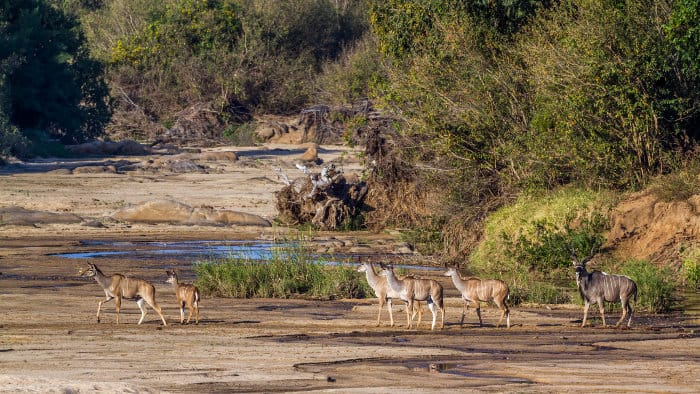
The species has a reasonably stable population count and isn’t considered endangered. Despite a variety of predators and the threat of humans.
The greater kudu has an estimated 482,000 global population headcount. With approximately 15% in protected areas and another 61% on private land.
Greater Kudu Facts
This large antelope species is fascinating, with a few quirky facts that stand out from the rest.
- The greater kudu is the loudest of all antelope
- The number of spirals in a male’s horn relates to its age
- Although fierce in appearance, the horns are not used in defense against predators
- When running, kudus curl their tail to reveal the white underside and send an alarm signal for the rest of the herd to follow
Just the Tip of the Kudu Horn
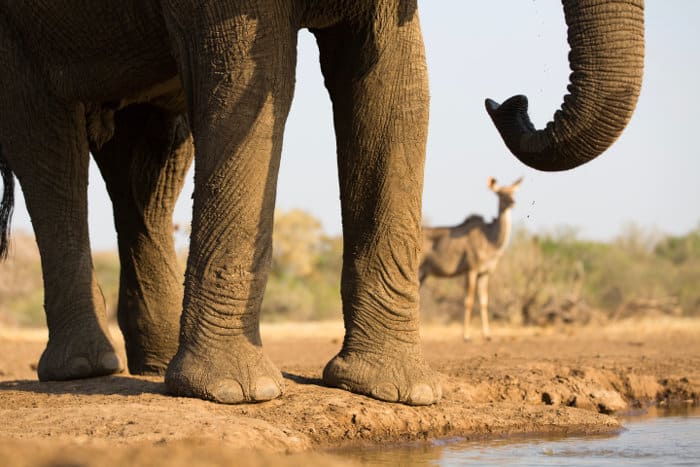
The greater kudu truly is a remarkable species. One that inspires awe for those lucky enough to watch them in the wild.
Their long spiraled horns, striped bodies, and large ears make them easy to identify. As shy and cautious creatures, you can count yourself fortunate if you get close enough to catch a snap.
Knowing about the greater kudu and their antics will increase your chance of a sighting. And grow your respect for the marvelous creatures in the process.
